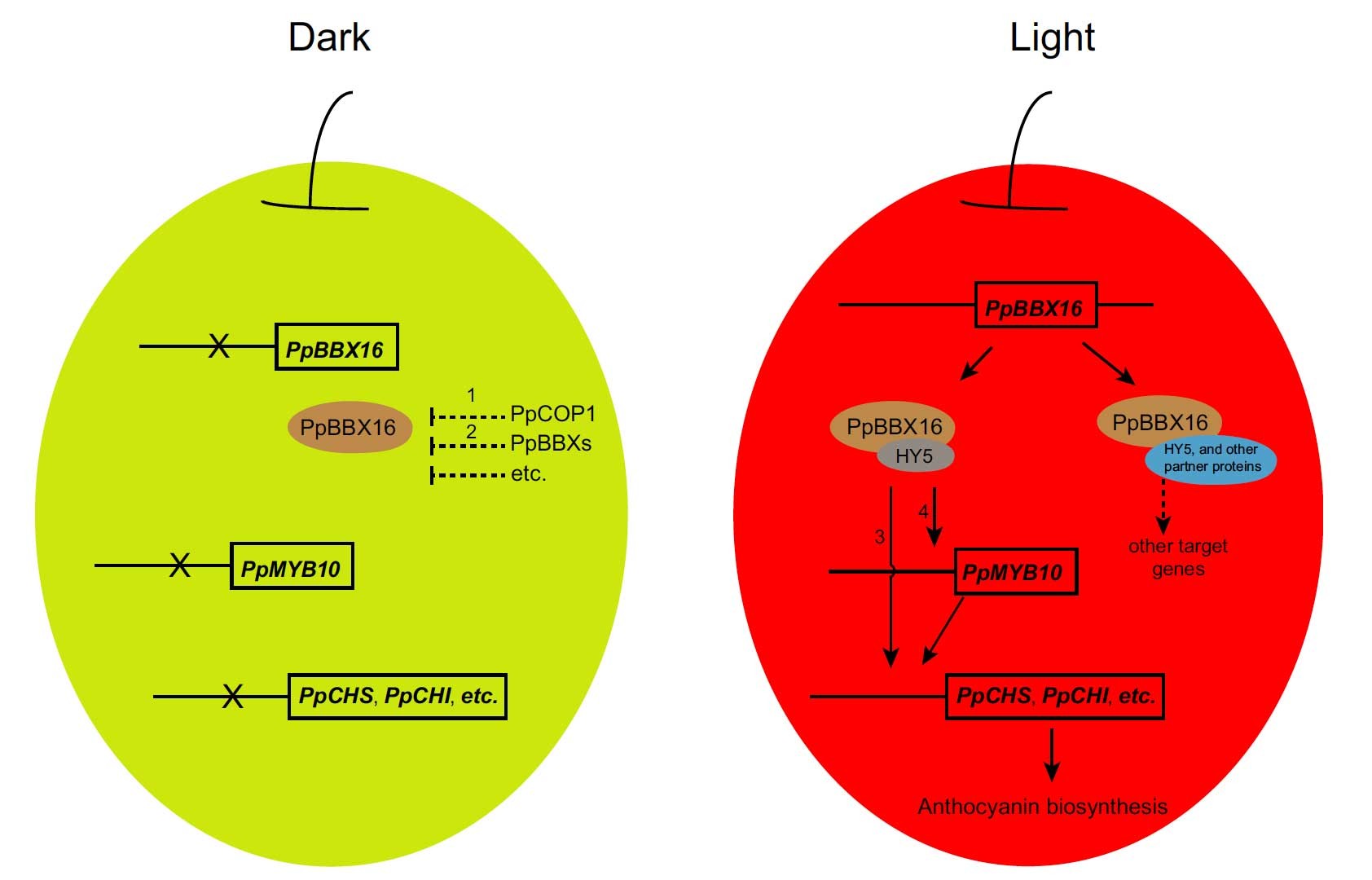博文
Plant Biotechnol J:梨子果皮着红色的分子调控机制
||
BBX16, a B‐box protein, positively regulates light‐induced anthocyanin accumulation by activating MYB10 in red pear
First author: Songling Bai; Affiliations: Zhejiang University (浙江大学): Hangzhou, China
Corresponding author: Yuanwen Teng
The red coloration of pear (Pyrus pyrifolia) results from anthocyanin accumulation in the fruit peel. Light is required for anthocyanin biosynthesis in pear. A pear homolog of Arabidopsis thaliana BBX22, PpBBX16, was differentially expressed after fruits were removed from bags and may be involved in anthocyanin biosynthesis. Here, the expression and function of PpBBX16 were analysed. PpBBX16's expression was highly induced by white‐light irradiation, as was anthocyanin accumulation. PpBBX16's ectopic expression in Arabidopsis increased anthocyanin biosynthesis in the hypocotyls and tops of flower stalks. PpBBX16 was localized in the nucleus and showed trans‐activity in yeast cells. Although PpBBX16 could not directly bind to the promoter of PpMYB10 or PpCHS in yeast one‐hybrid assays, the complex of PpBBX16/PpHY5 strongly trans‐activated anthocyanin pathway genes in tobacco. PpBBX16's overexpression in pear calli enhanced the red coloration during light treatments. Additionally, PpBBX16's transient overexpression in pear peel increased anthocyanin accumulation, while virus‐induced gene silencing of PpBBX16 decreased anthocyanin accumulation. The expression patterns of pear BBX family members were analysed, and six additional BBX genes, which were differentially expressed during light‐induced anthocyanin biosynthesis, were identified. Thus, PpBBX16 is a positive regulator of light‐induced anthocyanin accumulation, but it could not directly induce the expression of the anthocyanin biosynthesis‐related genes by itself but needed PpHY5 to gain full function. Our work uncovered regulatory modes for PpBBX16 and suggested the potential functions of other pear BBX genes in the regulation of anthocyanin accumulation, thereby providing target genes for further studies on anthocyanin biosynthesis.
红色的梨是由于花青素在梨的果皮积累所导致的。在梨中,花青素的生物合成需要光的作用。拟南芥BBX22基因在梨中的同源基因PpBBX16在梨子果实去袋之后存在差异表达,说明其可能参与了花青素的合成。本文,作者研究了PpBBX16基因的表达和功能。PpBBX16基因的表达显著受到白光的诱导,正如花青素的积累一样。PpBBX16基因在拟南芥中的异位表达能够增加拟南芥下胚轴和花梗顶部的花青素合成。PpBBX16蛋白定位于细胞核,并且在酵母细胞中具有转录活性。尽管在酵母单杂试验中,PpBBX16蛋白并不能直接结合到PpMYB10或者PpCHS基因的启动子区,但在烟草中PpBBX16/PpHY5复合物能够显著激活花青素通路上的基因。梨愈伤组织中过表达PpBBX16基因能够增强光照下着红色,而通过病毒诱导的PpBBX16基因沉默能够降低花青素的积累。作者进一步分析了梨中BBX基因家族成员的表达模式,鉴定了6个BBX基因在光诱导的花青素生物合成阶段存在差异表达。因此,PpBBX16是光诱导花青素积累的正向调控因子,但其并不能直接诱导花青素生物合成相关基因的表达,而是需要与PpHY5一起发挥功能。本文的研究揭示了PpBBX16基因的作用机制,并且揭示了梨中其它BBX基因在花青素积累中的调控作用,因此为花青素生物合成研究提供了一些靶基因。
通讯:滕元文(https://person.zju.edu.cn/ywteng/0.html)
个人简介:1984年,西北农业大学,学士;1987年,西北农业大学,硕士;1998年,日本鸟取大学,博士。
研究方向:梨属植物遗传多样性与分子系统发育研究;红梨着色生理和分子调控研究;梨休眠的调控机制;梨果实品质形成机制研究;梨栽培技术开发。
doi: https://doi.org/10.1111/pbi.13114
Journal: Plant Biotechnology Journal
First Published: April 08, 2019
https://blog.sciencenet.cn/blog-3158122-1174671.html
上一篇:Horticulture Research:欧洲李韧皮部组织在叶片发育时期的基因表达动态
下一篇:Nature Genetics:现代硬粒小麦栽培种Svevo基因组
全部作者的其他最新博文
- • Plant Physiology:CsMADS3促进柑果中的叶绿素降解和类胡萝卜素合成(华中农业大学)
- • Molecular Plant:LBD11-ROS反馈调节作用于拟南芥的维管形成层增殖和次生生长(浦项科技大学)
- • Science Advances:根结线虫通过调控植物的CLE3-CLV1模块,促进侵染进程(日本熊本大学)
- • Nature Communications:油菜素内酯参与植物营养生长期转变的分子机制解析(浙江农林大学)
- • Current Biology:光合作用产生的蔗糖驱动侧根“生物钟”(德国弗莱堡大学)
- • PNAS:花同源异型基因在叶中被抑制、花中被激活的分子机制(南卡罗来纳大学)

